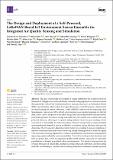The Design and Deployment of a Self-Powered, LoRaWAN-Based IoT Environment Sensor Ensemble for Integrated Air Quality Sensing and Simulation
Author(s)
Wijeratne, Lakitha O. H.; Kiv, Daniel; Waczak, John; Dewage, Prabuddha; Balagopal, Gokul; Iqbal, Mazhar; Aker, Adam; Fernando, Bharana; Lary, Matthew; Sooriyaarachchi, Vinu; Patra, Rittik; Desmond, Nora; Zabiepour, Hannah; Xi, Darren; Agnihotri, Vardhan; Lee, Seth; Simmons, Chris; Lary, David J.; ... Show more Show less
Downloadair-03-00009.pdf (6.157Mb)
Publisher with Creative Commons License
Publisher with Creative Commons License
Creative Commons Attribution
Terms of use
Metadata
Show full item recordAbstract
The goal of this study is to describe a design architecture for a self-powered IoT (Internet of Things) sensor network that is currently being deployed at various locations throughout the Dallas-Fort Worth metroplex to measure and report on Particulate Matter (PM) concentrations. This system leverages diverse low-cost PM sensors, enhanced by machine learning for sensor calibration, with LoRaWAN connectivity for long-range data transmission. Sensors are GPS-enabled, allowing precise geospatial mapping of collected data, which can be integrated with urban air quality forecasting models and operational forecasting systems. To achieve energy self-sufficiency, the system uses a small-scale solar-powered solution, allowing it to operate independently from the grid, making it both cost-effective and suitable for remote locations. This novel approach leverages multiple operational modes based on power availability to optimize energy efficiency and prevent downtime. By dynamically adjusting system behavior according to power conditions, it ensures continuous operation while conserving energy during periods of reduced supply. This innovative strategy significantly enhances performance and resource management, improving system reliability and sustainability. This IoT network provides localized real-time air quality data, which has significant public health benefits, especially for vulnerable populations in densely populated urban environments. The project demonstrates the synergy between IoT sensor data, machine learning-enhanced calibration, and forecasting methods, contributing to scientific understanding of microenvironments, human exposure, and public health impacts of urban air quality. In addition, this study emphasizes open source design principles, promoting transparency, data quality, and reproducibility by exploring cost-effective sensor calibration techniques and adhering to open data standards. The next iteration of the sensors will include edge processing for short-term air quality forecasts. This work underscores the transformative role of low-cost sensor networks in urban air quality monitoring, advancing equitable policy development and empowering communities to address pollution challenges.
Date issued
2025-03-12Department
Massachusetts Institute of Technology. Department of Electrical Engineering and Computer ScienceJournal
Air
Publisher
Multidisciplinary Digital Publishing Institute
Citation
Wijeratne, L.O.H.; Kiv, D.; Waczak, J.; Dewage, P.; Balagopal, G.; Iqbal, M.; Aker, A.; Fernando, B.; Lary, M.; Sooriyaarachchi, V.; et al. The Design and Deployment of a Self-Powered, LoRaWAN-Based IoT Environment Sensor Ensemble for Integrated Air Quality Sensing and Simulation. Air 2025, 3, 9.
Version: Final published version